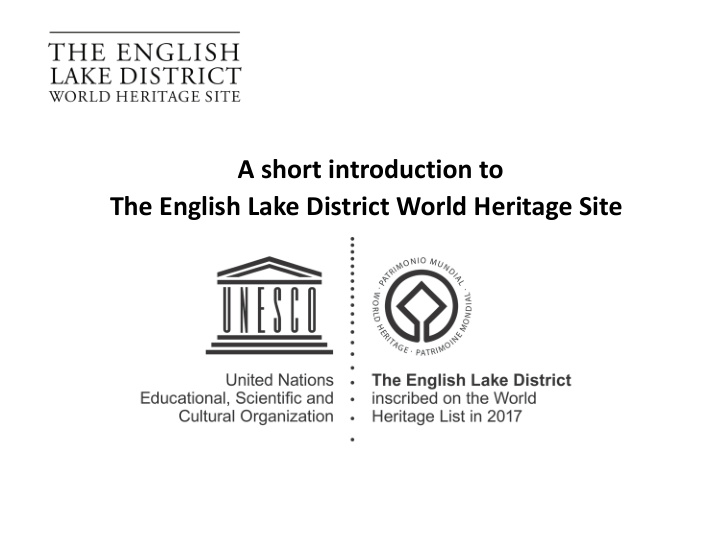



A short introduction to The English Lake District World Heritage Site
What is World Heritage? • UNESCO's aim is "to contribute to the building of peace , the eradication of poverty, sustainable development and intercultural dialogue through education, the sciences, culture, communication and information." • “Heritage is our legacy from the past, what we live with today, and what we pass on to future generations. Our cultural and natural heritage are both irreplaceable sources of life and inspiration .” • “What makes the concept of World Heritage exceptional is its universal application. World Heritage Sites belong to all the peoples of the world, irrespective of the territory on which they are located.”
What are World Heritage Sites? • There are four different categories of World Heritage Sites: natural , cultural , mixed (both natural and cultural) and cultural landscape • As of summer 2018, there are a total of 1,092 World Heritage Sites located in 167 different countries • Of these sites, 845 are cultural, 209 are natural and 38 are mixed properties • Within the 845 cultural properties, 102 are cultural landscapes, a category only introduced in 1992
Central Amazon Basin Great Barrier Reef Dorset & East Devon Jurassic Coast Great Smokey Mountains NP
Memphis & the Pyramid Fields Taj Mahal Frontiers of the Roman Empire Venice and its lagoon
Tasmanian Wilderness Machu Picchu St Kilda Mount Perdu
Rice Terraces of the Philippine Cordilleras The Causses & Cévennes English Lake District Blaenavon
Lake District’s pathway to inscription • 1986 – nominated by UK as a ‘mixed’ World Heritage Site • 1989 – the Lakes nominated by UK as a ‘cultural’ site • 1992 – a new category of ‘c ultural landscape’ developed • 1999 – included in the UK’s revised Tentative List of WHSs • 2001 – Steering Group was formed • 2007 – World Heritage Site Coordinator appointed • 2009 – study commissioned on economic opportunities • 2010 – draft Nomination Document completed • 2011 – included in revised UK Tentative List of WHSs • 2012 – Technical Evaluation submitted, deferred till 2013 • 2013 – Technical Evaluation submitted to the DCMS for a second time • 2014 – Government decides that the Lakes is the UK’s WH nomination in 2016 • 2016 – Lakes’ bid submitted to UNESCO • 2016 – an assessment visit to scrutinize the Lake District’s bid is undertaken by experts from ICOMOS on behalf of UNESCO • 2017 – Lake District is announced as the UK’s newest World Heritage Site at UNESCO annual meeting in Krakow
• Big and complicated… • UK’s 31 st and largest WHS • Covers area 221,000 ha (as per 1951 National Park boundary) • Population of ~41k, with 61% working and 25% retired • There are ~23k homes with 68% owner occupied • 42k ha of SSSIs, 36k ha of SACs and ~2k ha NNRs • There are 16.5k archaeological sites and monuments including 333 scheduled ancient monuments, and ~1,800 listed buildings • There are 2,200 km of public footpaths and 121,000 ha of open access land • Tourism #s ~19m visits, worth £1.24bn (2015), and growing?
How does UNESCO decide how somewhere's special enough to be a WHS? • To be included on the World Heritage List, sites must be of Outstanding Universal Value (OUV) and meet at least one out of ten selection criteria as defined in UNESCO’s Operational Guidelines…the Lakes meets three… • Outstanding Universal Value (OUV) means cultural and/ or natural significance which is so exceptional as to “ transcend national boundaries and to be of common importance for present and future generations of all humanity ”…or those reasons why the Lakes is so internationally important…
Why are the Lakes a World Heritage Site? Those reasons are three intertwining and interdependent themes that reflect the criteria for inscription and attributes: • Identity – a landscape of exceptional beauty, shaped by farming traditions and local industry for over 1,000 years, which give it special character • Inspiration – a landscape which has inspired artistic and literary movements and generated ideas about landscapes that have had global influence • Conservation – a landscape which has been the catalyst for key developments in the national and international protection of landscapes
Identity – natural ‘canvas’
Identity – artefacts now part of the landscape
Identity – traditional farming
Identity – traditional farming
Identity – traditional farming
Identity – traditional farming
Identity – traditional farming
Identity – traditional farming
Identity – mining and quarrying
Identity – other industries
Inspiration – Picturesque
Inspiration – Picturesque
Inspiration – villa building Inspiration – designed landscapes
Inspiration – Romanticism
Conservation – Crow Park
Conservation – Thirlmere
Conservation – protection through legislation
Conservation – protection through ownership
Managing an evolving masterpiece… …via the Lake District National Park Partnership
Managing the World Heritage Site • Governance and structures • Working groups – marketing, technical advisory group, funding, other non official groups… • Management Plan • Work programmes and projects • Monitoring the WHS • WHS Coordinator • WHS Engagement Officer
Benefits • Stronger, more joined-up Lakes-wide partnership • Platform for conversations, discussions and solutions • Global spotlight, recognition and awareness • Competitive advantage • Increase in international visitors and revenues • Leverage for funding • New Lakes stories to tell; new interpretation strategy • WHS Branding
Challenges • Tourism impact • Threats to OUV – managing developments • It’s not ‘Culture vs. Nature’ • Infrastructure pressures • Brexit • CAP • Partners not working in a partnership • Addressing UNESCO’s recommendations
If you have questions or want more information… • UNESCO http://whc.unesco.org/en/list/ • English Lake District World Heritage Site www.lakesworldheritage.co.uk • Lake District National Park Authority www.lakedistrict.gov.uk • National Trust www.nationaltrust.org.uk/days- out/regionnorthwest/lake-district • Cumbria Tourism (for visitors) www.golakes.co.uk • Cumbria Tourism (for businesses) www.cumbriatourism.org/what-we-do • World Heritage UK www.worldheritageuk.org • Twitter: @EnglishLakesWHS • Email: lakeswh@lakedistrict.gov.uk
Recommend
More recommend